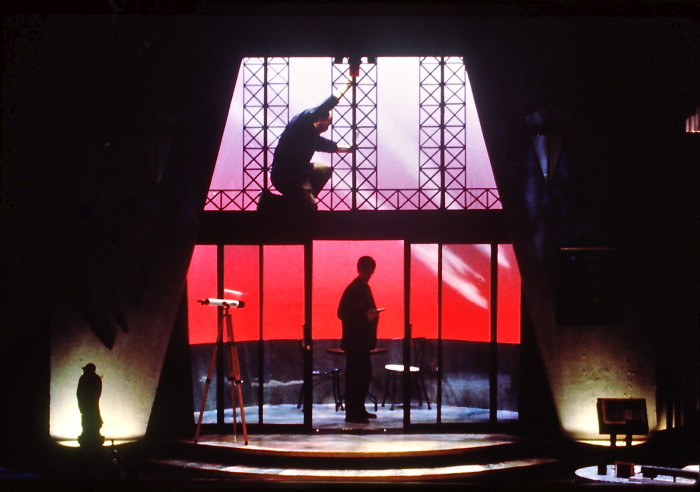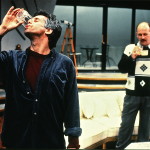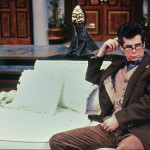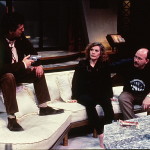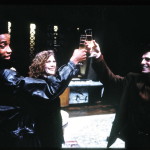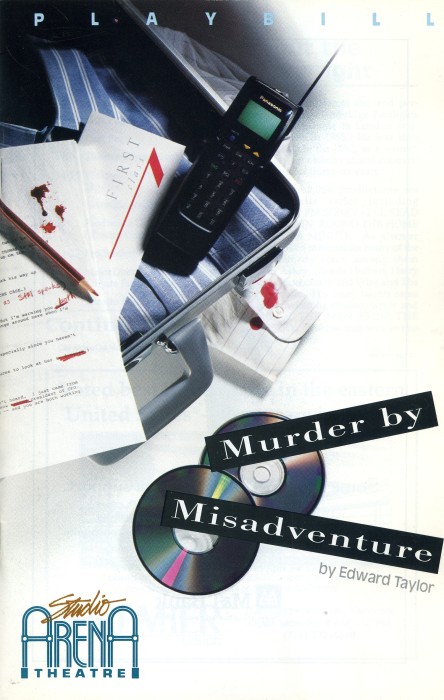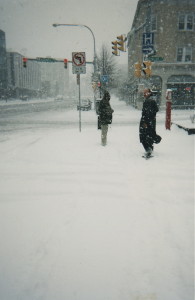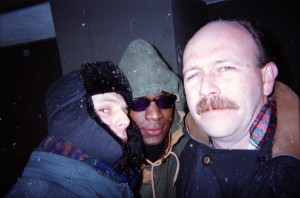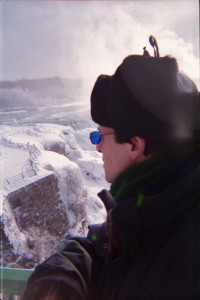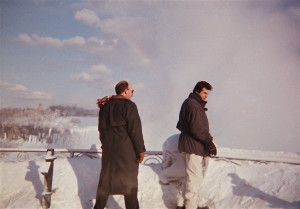Above: T. Ryder Smith and Julian Gamble; T. Ryder; T. Ryder, Alison White and Julian Gamble; Kenneth Ransom , Alison White and T. Ryder (StageWest); T. Ryder and Nicole Orth-Pallavincini (Studio Arena); Adrian Roberts and Nicole.
Excerpts from the reviews
Full reviews are below
“When it is good, it is very good, and it’s first act is excellent . . . Playwright Taylor’s dialogue . . . is nearly flawlessly engaging and humorous, creating eddies of tension, comic-tinged ironies and venal innuendoes . . . T. Ryder Smith is particularly effective as the irritating Paul Riggs, creating a swirl of smarmy nastiness and charm . . . I suspect that much of the let-down of Act Two stems from . . . the [prolonged] absence of Ryder Smith’s character from the stage . . . “ Jim Santella, NPR/WBFO radio
“As deceptions go, it is pretty good. And the final rabbit out of the hat is really very good . . . The first scene is masterly: Gamble’s Harold is responsible, cautious, meticulous in his work habits. Smith’s Paul is smaller, wiry, irresponsible, sloppy, averse to work. He drinks, blows his money, slums, but gets these terrific ideas for murder-mystery plots. . . . Gamble and Smith make a good pair.” Terry Doran, The Buffalo News
Publicity
Offstage
It snowed relentlessly in Buffalo, and was frigidly cold. So on a day off we went to Niagara Falls. Since it was even colder there.
Full reviews
WBFO FM, Jim Santella – Not Half Bad. Every child learns that “Curiosity killed the cat but, satisfaction brought it back”. This may be the overriding factor in the popularity of murder mystery plays. As dramatic works, they are often on shaky ground. They are certainly gimmicky and plot-driven. But, there is no denying their popularity and when done well, they are highly entertaining. “Murder By Misadventure,” The Studio Arena’s fifth production of the season, in what has become their seasonal murder mystery presentation, is like the little girl with the curl in the middle of her forehead.
When it is good, it is very good and its first act is excellent. Actor’s, set and direction meld into an entertaining melange of comedy, suspense and menace. But something happens in the second act that disappoints rather than satisfies. It’s like sitting down to a seven-course meal and finding the first four dishes delicious and the last three rather ordinary.
Successful murder-mysteries depend upon unraveling a rather arcane plot. Audiences usually gauge a play’s success by their ability to figure out the plot twists and turns before they actually occur. If they’re too successful, they’re curiosity is disappointed.
They’re aren’t many murder-mystery plays that bear repeated viewing. Primarily because their appeal lies in discovering the unknown. Once the crime has been solved, most of the entertainment is gone. The best approach to viewing a murder-mystery is to enter into the spirit of the production. Be enveloped in its web of intrigue.
To quibble that events are impossible or improbable misses the fun. Give the playwright latitude for creative invention. Most authors understand that murder-mysteries, like farce, operate on speed and therefore construct complex chinese boxes to amuse and entertain. The audience must never be given too much time to think about the unlikelihood of events. Speech is usually pregnant with possibilities. Nothing is as it seems.
Threads of verbal clues are woven seamlessly into the cloth of dialogue. When done with craft, imagination and style, the murder-mystery is pregnant with possibility. It is no secret that murder-mysteries are written backwards. They should also be discovered by an audience with a mixture of anticipation and hindsight.
Edward Taylor’s “Murder By Misadventure” succeeds gloriously in its forward-reaching Act One and then muddles about in Act Two retreating into a de-accleration of momentum. “Less is more” is a good rule-of-thumb both for writing and reviewing murder-mysteries. Since the fun of this kind of play depends upon an audience entering the theatre with a tabula rasa, a blank slate untainted by preconceived notions or details of the story, I shall do my best to tease without revealing.
Harold Kent (Julian Gamble) is the sensible, money-oriented half of a successful murder-mystery writing team. His partner Paul Riggs (T. Ryder Smith), is creatively brilliant but also irresponsible and besotted. One of Riggs highly inventive plots hinges on “murder by misadventure” a term taken from British law that describes an accidental death caused while doing a lawful act. The fictional plot becomes the spine of the stage drama.
Harold’s wife Emma (Nicole Orth-Pallavicini) seems to be the buffer in this contest of greed, jealously and show biz pettiness.
Director Frederick King Keller, who has directed the Studio Arena’s last three murder-mysteries, says”Murder By Misadventure” is “…about power, control, and getting ahead,often at the expense of others.” It’s a theme he should know about having worked both on television and Hollywood films. Act one pits the two writers against one another in a scintillating conflict of wills and personalities. It is humorously written, laced with intrigue and menace and well acted. Smith is particularly effective as the irritating Paul Riggs creating a swirl of smarmy nastiness and charm. Gamble’s work is not as flashy but like a good straight man, his contribution is invaluable. Despite the other two characters, this play is essentially a two-hander. I suspect that much of the let down in act two stems from two causes, one of them being the absence of Ryder Smith’s character from the stage. The other is Adrian Roberts’ Inspector Egan.
Granted playwright Taylor has done him a disservice by giving the actor some impossible dialogue and action to convey but the actor does little to convince us that this man, regardless of his ulterior motives, is authentic. Ms Orth-Pallavicini’s role and character assume more prominence as the play progresses and she is quite good in a part that is primarily window dressing for the principals. Director Keller and set and lighting designer Paul Wonsek’s work create the proper mood and tone for this contemporary murder-mystery set in a posh penthouse apartment overlooking the English Channel.
Playwright Taylor’s dialogue, especially in act one is nearly flawlessly engaging and humorous, creating eddies of tension, comic tinged ironies, and venal innuendos. If act two sags a bit, it is still entertaining enough to provide an evening’s curiosity-satisfying pleasure for local murder-mystery fans.
[previous] [next]
